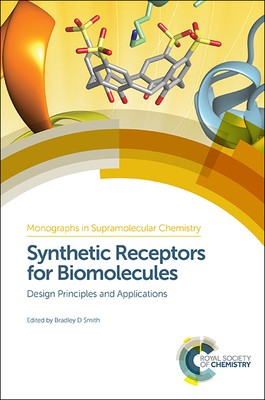
- We will send in 10–14 business days.
- Publisher: Royal Society of Chemistry
- ISBN-10: 1849739714
- ISBN-13: 9781849739719
- Format: 16.3 x 23.6 x 3.6 cm, kieti viršeliai
- Language: English
- SAVE -10% with code: EXTRA
Synthetic Receptors for Biomolecules (e-book) (used book) | bookbook.eu
Reviews
Description
Synthetic receptor molecules, molecules that mimic antibody recognition, are widely used for developing drug leads; drug delivery vehicles; imaging agents; sensing agents; capture agents and separation systems. Synthetic Receptors for Biomolecules covers the most effective synthetic receptors for each major class of biomolecules within the context of specific applications.
The book starts with an introduction to the applications of synthetic receptors for biomolecules and their design and synthesis for biomolecule recognition. Dedicated chapters then cover synthetic receptors for the key biomolecules including inorganic cations; small organic and inorganic anions; carbohydrates; nucleosides/nucleotides; oligonucleotides; amino acids and peptides; protein surfaces as well as non-polar and polar lipids; Each chapter follows the same systematic format of (a) chemical structures and physical properties of the biomolecule, (b) biological recognition of the biomolecule, (c) synthetic receptors for the biomolecule, (d) future directions and challenges.
Edited by a leader in the field, the book is written in an accessible style for readers new to supramolecular chemistry or for those looking for synthetic receptors.
EXTRA 10 % discount with code: EXTRA
The promotion ends in 21d.14:01:27
The discount code is valid when purchasing from 10 €. Discounts do not stack.
- Publisher: Royal Society of Chemistry
- ISBN-10: 1849739714
- ISBN-13: 9781849739719
- Format: 16.3 x 23.6 x 3.6 cm, kieti viršeliai
- Language: English English
Synthetic receptor molecules, molecules that mimic antibody recognition, are widely used for developing drug leads; drug delivery vehicles; imaging agents; sensing agents; capture agents and separation systems. Synthetic Receptors for Biomolecules covers the most effective synthetic receptors for each major class of biomolecules within the context of specific applications.
The book starts with an introduction to the applications of synthetic receptors for biomolecules and their design and synthesis for biomolecule recognition. Dedicated chapters then cover synthetic receptors for the key biomolecules including inorganic cations; small organic and inorganic anions; carbohydrates; nucleosides/nucleotides; oligonucleotides; amino acids and peptides; protein surfaces as well as non-polar and polar lipids; Each chapter follows the same systematic format of (a) chemical structures and physical properties of the biomolecule, (b) biological recognition of the biomolecule, (c) synthetic receptors for the biomolecule, (d) future directions and challenges.
Edited by a leader in the field, the book is written in an accessible style for readers new to supramolecular chemistry or for those looking for synthetic receptors.


Reviews